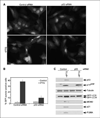p53-Dependent and p53-independent activation of autophagy by ARF
- PMID: 18199527
- PMCID: PMC3737745
- DOI: 10.1158/0008-5472.CAN-07-2069
p53-Dependent and p53-independent activation of autophagy by ARF
Abstract
The ARF tumor suppressor is a crucial component of the cellular response to hyperproliferative signals, including oncogene activation, and functions by inducing a p53-dependent cell growth arrest and apoptosis program. It has recently been reported that the ARF mRNA can produce a smARF isoform that lacks the NH(2)-terminal region required for p53 activation. Overexpression of this isoform can induce autophagy, a cellular process characterized by the formation of cytoplasmic vesicles and the digestion of cellular content, independently of p53. However, the level of this isoform is extremely low in cells, and it remains unclear whether the predominant form of ARF, the full-length protein, is able to activate autophagy. Here, we show that full-length ARF can induce autophagy in 293T cells where p53 is inactivated by viral proteins, and, notably, expression of the NH(2)-terminal region alone, which is required for nucleolar localization, is sufficient for autophagy activation, independently of p53. Given the reported ability of p53 to induce autophagy, we also investigated the role of p53 in ARF-mediated autophagy induction. We found that full-length ARF expression induces p53 activation and promotes autophagy in a p53-positive cell line, and that ARF-mediated autophagy can be abrogated, at least in part, by RNAi-mediated knockdown of p53 in this cellular context. Thus, our findings modify the current view regarding the mechanism of autophagy induction by ARF and suggest an important role for autophagy in tumor suppression via full-length ARF in both p53-dependent and p53-independent manners, depending on cellular context.
Figures




References
-
- Sherr CJ. Divorcing ARF and p53: an unsettled case. Nat Rev Cancer. 2006;6:663–673. - PubMed
-
- Zhang Y, Xiong Y, Yarbrough WG. ARF promotes MDM2 degradation and stabilizes p53: ARF-INK4a locus deletion impairs both the Rb and p53 tumor suppression pathways. Cell. 1998;92:725–734. - PubMed
-
- Pomerantz J, Schreiber-Agus N, Liegeois NJ, et al. The Ink4a tumor suppressor gene product, p19Arf, interacts with MDM2 and neutralizes MDM2’s inhibition of p53. Cell. 1998;92:713–723. - PubMed
-
- Chen D, Kon N, Li M, Zhang W, Qin J, Gu W. ARF-BP1/Mule is a critical mediator of the ARF tumor suppressor. Cell. 2005;121:1071–1083. - PubMed
Publication types
MeSH terms
Substances
Grants and funding
LinkOut - more resources
Full Text Sources
Research Materials
Miscellaneous

